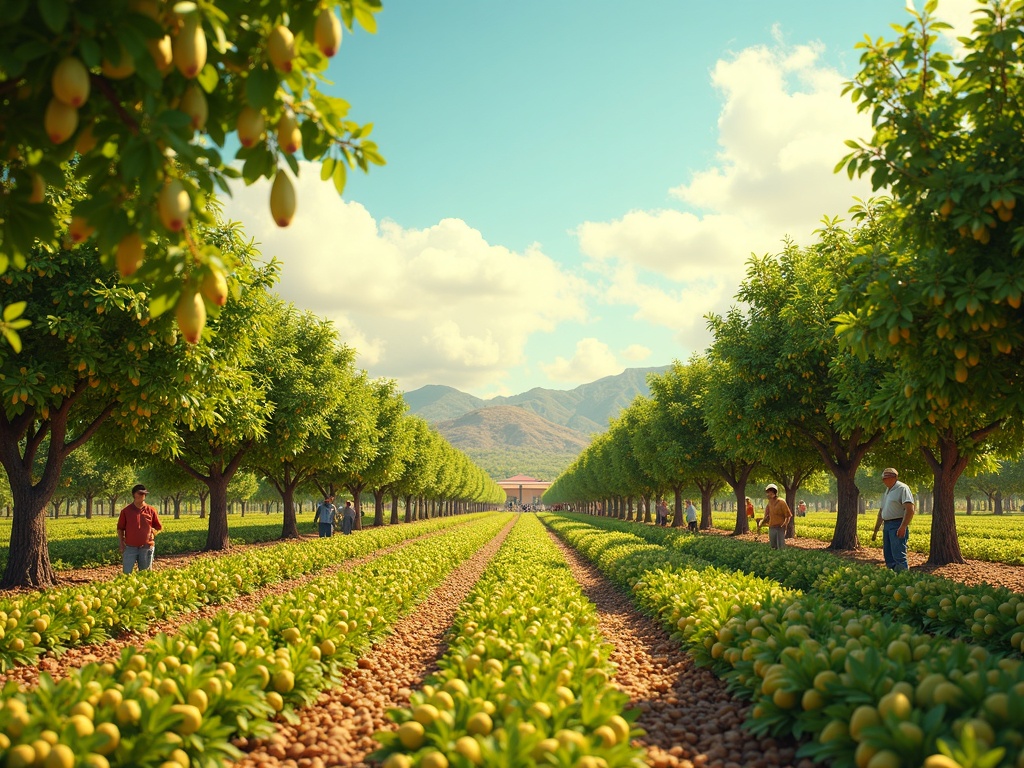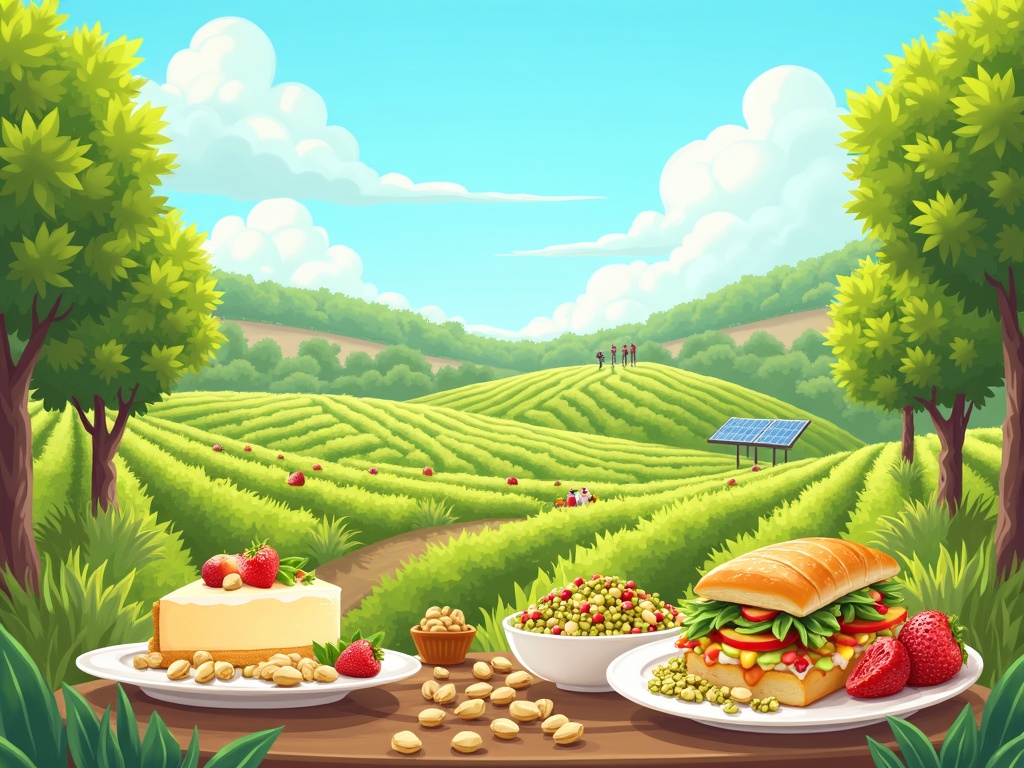Pistachios have emerged as a global superfood powerhouse, with the market hitting $3.8 billion in 2021 and set to reach $5.1 billion by 2028. Their flexibility goes well beyond simple snacking, appearing in everything from decadent desserts to savory dishes while delivering impressive nutritional benefits that support heart health, weight management, and overall wellness.
Find In This Article
Key Takeaways
- California produces 99% of all U.S. pistachios, positioning America as a leading player in the global pistachio market.
- A single 1-ounce serving of pistachios provides 160 calories, 6 grams of protein, 13 grams of heart-healthy fats, and 3 grams of fiber.
- Pistachios contain lutein and zeaxanthin for eye health, plus flavonoids and phenolic compounds that help fight inflammation.
- These sustainable, drought-tolerant trees require less water than many crops, making them environmentally friendly while supporting over 30,000 U.S. jobs.
- The pistachio market continues growing at a steady 4.0% annual rate, driving innovation in both traditional products and cutting-edge food technology.
The Rise of Pistachio: A Global Superfood
Pistachios have burst onto the global food scene with impressive momentum. The worldwide market for these green gems reached a staggering $3.8 billion in 2021, with projections pointing to $5.1 billion by 2028. I’ve watched this trend develop over recent years as pistachios transitioned from occasional snack to celebrated superfood.
From Niche to Mainstream
California stands as the undisputed pistachio powerhouse, producing an astonishing 99% of all U.S. pistachios. This dominance has helped position America as a leading player in the global market. Many don’t realize pistachios belong to the cashew family, with 16 distinct species growing around the world. Their distinctive flavor has made them popular ingredients in everything from creative mini desserts to savory main dishes.
Nutritional Powerhouse
The nutritional profile of pistachios tells a compelling story about their superfood status. A single 1-ounce serving delivers:
- 160 calories (perfect for portion control)
- 6 grams of complete protein
- 13 grams of heart-healthy fats
- 3 grams of fiber for digestive health
These numbers explain why health-conscious consumers gravitate toward pistachios as a snack option. Their protein content makes them particularly valuable for plant-based diets, while their healthy fat profile supports cardiovascular health. I often recommend pistachios to clients looking for nutrient-dense additions to baked cheesecake recipes or as toppings for moist chocolate cakes.
The versatility of pistachios extends beyond snacking. Their distinctive flavor pairs beautifully with citrus in orange cake recipes and adds complexity to lemon cheesecake. For something more indulgent, try incorporating chopped pistachios into a rocky road recipe for color contrast and nutritional boost.
The meteoric rise of pistachios reflects broader shifts toward functional foods that taste great while delivering significant health benefits. Their continued growth trajectory suggests consumers have only begun to explore the potential of this remarkable nut.
Why These Nuts Are Good For You
I’ve discovered that pistachios aren’t just delicious – they’re nutritional powerhouses packed with health benefits. These vibrant green nuts offer impressive advantages for overall wellness that make them worth adding to your daily diet.
Vision and Inflammatory Benefits
Pistachios contain significant amounts of lutein and zeaxanthin, two antioxidants that play a crucial role in maintaining eye health. These compounds help filter harmful blue light and protect the retina from oxidative damage, potentially reducing the risk of age-related macular degeneration.
The flavonoids and phenolic compounds found in pistachios are equally impressive. These natural plant chemicals help fight inflammation throughout the body. By incorporating pistachios into desserts or eating them as a snack, you can support your body’s natural anti-inflammatory processes, potentially easing symptoms associated with chronic inflammation.
Weight Management and Heart Health
For those focused on maintaining a healthy weight, pistachios offer a smart snacking option. Their protein, fiber, and healthy fat content significantly increases satiety – that feeling of fullness after eating. This satisfaction factor can help prevent overeating and unnecessary snacking between meals, making weight management more achievable.
Pistachios have shown remarkable effects on cholesterol levels too. According to a study published in the American Journal of Clinical Nutrition, regular pistachio consumption can reduce cholesterol levels by approximately 5.5%. That’s a substantial improvement that could make a real difference in heart health over time.
The heart-healthy benefits don’t stop there. Pistachios are rich in antioxidants that fight oxidative stress and contain compounds that support cardiovascular function. Their unique nutrition profile includes:
- Potassium for healthy blood pressure regulation
- L-arginine, an amino acid that helps improve blood vessel function
- Plant sterols that block cholesterol absorption
- Fiber that helps remove cholesterol from the body
I find that adding pistachios to my diet is surprisingly easy. They make an excellent topping for homemade cheesecake recipes or can be crushed and used as a crust for desserts. The natural sweetness and distinctive flavor of pistachios also pairs perfectly with chocolate cake recipes, creating a delicious contrast.
For a quick snack, I keep a small container of shelled pistachios in my bag. The act of opening the shells (if you buy them unshelled) can also slow down eating, helping with portion control and mindful consumption.
Pistachios can transform ordinary dishes into something special. Try sprinkling chopped pistachios over yogurt, adding them to salads, or incorporating them into mini dessert ideas for an added nutritional boost and textural contrast.
For the best nutritional value, I opt for unsalted or lightly salted varieties to keep sodium intake in check. The natural flavor of pistachios is so rich and satisfying that excessive salt isn’t necessary.
Their versatility extends to both sweet and savory applications. Pistachios add wonderful texture and flavor to rocky road treats or can be processed into a creamy paste for baked cheesecake recipes.
The combination of protein, healthy fats, fiber, and micronutrients makes pistachios a truly balanced food. Unlike many other snacks that provide empty calories, these nuts deliver substantial nutrition in each bite, supporting everything from cellular health to digestive function.
Popular Ways to Enjoy Pistachios
Pistachios have earned their place as one of the most versatile nuts in culinary applications. I’ve seen them transform dishes from ordinary to extraordinary with their distinctive flavor and appealing green hue. Their popularity extends far beyond simple snacking, finding their way into both traditional favorites and innovative new creations.
From Traditional Favorites to Modern Innovations
Traditionally, pistachios have been celebrated in desserts like ice cream, where their nutty essence creates a sophisticated flavor profile that pairs beautifully with the creamy base. I’ve found that pistachio mini desserts make perfect bite-sized treats for gatherings. The nuts also star in baklava, the Middle Eastern pastry where they’re layered between flaky phyllo dough and soaked in sweet syrup. Pistachio butter, similar to other nut butters, offers a spreadable form that captures the pure essence of these green gems.
In recent years, I’ve noticed pistachios gaining popularity in more contemporary applications. They’ve become a go-to ingredient for adding crunch and nutrition to salads – whether sprinkled whole or roughly chopped. Their earthy flavor and texture make them perfect partners with bitter greens, sweet fruits, and tangy cheeses.
Pistachios have also revolutionized pesto recipes. While traditionally made with pine nuts, pistachio-based alternatives offer a unique twist with their distinctive color and flavor profile. This substitution creates a sauce that’s both visually striking and deliciously different from classic versions.
As nutritious toppings, pistachios shine across various dishes:
- Breakfast bowls featuring yogurt, oatmeal, or açaí bases
- Decadent chocolate cakes and brownies where they add texture contrast
- Roasted vegetables that benefit from their crunchy texture
- Middle Eastern rice dishes where they add color and texture
- Citrus-forward desserts that pair beautifully with pistachio’s flavor
The commercial food industry has fully embraced pistachios, creating countless ready-to-enjoy products. Flavored roasted varieties range from simple salted versions to sweet honey-glazed options and bold spicy selections. These convenient snacks make it easy to enjoy pistachios on the go.
Pistachio has become a premium flavor in the frozen dessert world, appearing in both gelato and specialty ice cream varieties. Its distinctive taste creates a sophisticated alternative to more common flavors.
The health food industry has incorporated pistachios into protein bars, capitalizing on their protein content and distinctive flavor to create nutritionally dense snacks. Meanwhile, nut butter spreads featuring pistachios offer a unique alternative to peanut or almond varieties, with their distinctive color and flavor making them stand out on shelves.
What makes pistachios truly exceptional is their ability to cross between sweet and savory applications with ease. In savory dishes, their subtle sweetness provides balance, while in desserts, their earthiness prevents treats from becoming cloying. This adaptability makes them perfect for cheesecake toppings and crusts, meat rubs, pasta dishes, and countless other culinary creations.
Whether you’re a culinary professional or home cook, pistachios offer endless possibilities for enhancing dishes with their unique flavor, color, and texture.

Growing Green: Sustainability in Pistachio Farming
Pistachio farming stands out as a model of agricultural sustainability in our changing climate. I’ve seen firsthand how these resilient trees provide economic benefits while requiring fewer resources than many other crops. This perfect balance makes pistachios a smart choice for both farmers and environmentally conscious consumers.
Water-Efficient Marvels
Pistachios shine as drought-tolerant champions in a world increasingly concerned with water conservation. Unlike many traditional crops, pistachio trees have remarkably lower water requirements, making them ideal for regions facing water scarcity challenges. Their deep root systems allow them to access groundwater sources that remain untapped by other plants.
The natural adaptability of pistachio trees to arid conditions makes them perfectly suited for cultivation in dry climates. These hardy trees thrive in hot, dry summers and cool winters – precisely the conditions found in major growing regions like California’s Central Valley. This natural fit reduces the need for excessive irrigation and helps preserve precious water resources.
California growers have taken significant steps to maximize water efficiency through:
- Drip irrigation systems that deliver water directly to root zones
- Soil moisture monitoring technology that prevents overwatering
- Deficit irrigation strategies during specific growth stages
- Improved water storage facilities to capture rainfall
Economic and Environmental Impact
The pistachio industry doesn’t just benefit the environment—it creates significant economic opportunity. The industry supports over 30,000 U.S. jobs across farming, processing, transportation, and retail sectors. These employment opportunities strengthen rural economies and provide stable livelihoods for thousands of families.
Beyond job creation, pistachio farmers have embraced sustainable pest management practices that reduce reliance on chemical interventions. California growers have pioneered integrated pest management approaches that include:
- Beneficial insect releases that target specific pests without harming the broader ecosystem
- Pheromone disruption techniques that interfere with pest reproduction cycles
- Strategic timing of interventions based on scientific monitoring rather than calendar-based applications
- Cover cropping to improve soil health and increase biodiversity
I’ve noticed that many pistachio orchards now feature solar panels alongside their trees, generating clean energy while farming continues underneath. This dual-use approach maximizes land efficiency and reduces the carbon footprint of operations. Some processing facilities have gone completely solar-powered, creating a more sustainable supply chain from orchard to consumer.
Soil health remains a top priority for pistachio farmers committed to long-term sustainability. Many growers incorporate composted organic materials into their farming practices, returning valuable nutrients to the soil while reducing waste. These practices build carbon-rich soils that sequester carbon dioxide from the atmosphere.
The lifecycle of pistachio trees further enhances their sustainability profile. With productive lifespans of 50+ years, these trees sequester carbon for decades while requiring fewer replantings than annual crops. Even when orchards reach the end of their productive lives, the wood can be repurposed or used as biofuel, creating a nearly closed-loop system.
For consumers looking to make environmentally responsible food choices, pistachios represent a smart option. Their relatively small environmental footprint compared to many other protein sources makes them a sustainable ingredient for innovative recipes and snacking. From pistachio-crusted fish to decadent desserts, these versatile nuts add nutrition and sustainability to countless dishes.
From Farm to Future
The pistachio market continues to flourish with a steady 4.0% Compound Annual Growth Rate, creating ripples across multiple industries and communities. I’ve tracked this remarkable growth trajectory and discovered how these little green nuts are making a massive impact on our food landscape and agricultural economies.
Economic and Agricultural Impact
Pistachio cultivation has transformed rural economies in major producing regions. Family farms in California, Iran, and Turkey have found economic stability through pistachio orchards, often transitioning from less profitable crops. These agricultural communities benefit from the long-term investment pistachios represent—trees produce for 50+ years, creating multigenerational income streams.
The economic benefits extend beyond farm gates:
- Processing facilities create year-round employment opportunities
- Export markets bring foreign currency into rural economies
- Support industries from irrigation specialists to packaging manufacturers flourish
- Sustainable farming practices protect local environments while ensuring future harvests
The steady 4.0% CAGR growth has encouraged more farmers to enter the market, expanding cultivation into new regions where climate conditions permit. This agricultural expansion supports food security while creating exciting opportunities for innovative pistachio products in both traditional and emerging markets.
Innovation and Consumer Trends
Product innovation in the food industry has exploded with pistachios appearing in everything from traditional sweets to cutting-edge food tech. The distinctive flavor profile makes pistachios incredibly versatile—they shine in both sweet and savory applications, allowing manufacturers to create distinctive offerings that stand out in crowded marketplaces.
Consumer awareness of pistachio health benefits continues driving demand. These nutrient-dense nuts provide protein, fiber, and healthy fats while offering a lower calorie count than many other nuts. The stunning green color (entirely natural) signals the presence of antioxidants, making pistachios visually appealing in today’s Instagram-focused food culture.
I’ve noticed pistachios increasingly featured in premium dessert creations and artisanal treats where their natural beauty enhances presentation. Simultaneously, they’ve entered the plant-based protein space as manufacturers seek alternatives to soy and pea proteins. Pistachio milk, protein powders, and meat alternatives represent the cutting edge of this market expansion.
The global demand for plant-based proteins has significantly boosted pistachio consumption. As consumers shift toward more sustainable diets, pistachios offer an environmentally friendly protein source compared to animal-based options. Their nutrient density makes them particularly valuable in developing next-generation plant-based foods that don’t compromise on nutritional quality.
Food manufacturers have embraced pistachios beyond traditional baking applications, incorporating them into savory spreads, grain bowls, and functional foods. The distinctive color creates visual appeal while their flavor profile pairs beautifully with both sweet ingredients and savory herbs and spices.
This explosion of pistachio products reflects broader market trends toward:
- Clean label ingredients with recognizable names
- Functional foods offering specific health benefits
- Sustainable protein sources with lower environmental impacts
- Globally-inspired flavors accessible to everyday consumers
The future looks exceptionally bright for pistachios as agricultural communities, food innovators, and health-conscious consumers all find value in these remarkable nuts. Their journey from farm to future represents a perfect alignment of agricultural tradition, culinary innovation, and modern nutritional science.

Sources:
IBISWorld, Pistachio Market Analysis
The American Society for Nutrition, Pistachios Health Benefits
California Pistachio Commission, Production Statistics
Healthline, Pistachios

